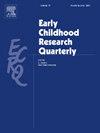在幼儿教育及照顾方面,困难类型与特殊需要援助的分配有何关系
IF 3.1
1区 教育学
Q1 EDUCATION & EDUCATIONAL RESEARCH
引用次数: 0
摘要
对有困难的儿童进行早期干预对他们的学业和生活结果至关重要。然而,我们对如何将特殊需要援助(SNA)分配给幼儿教育和护理(ECEC)知之甚少。本研究基于挪威母亲、父亲和儿童队列研究(MoBa),在控制了ECEC和人口统计学变量的情况下,研究儿童的困难类型是否能预测SNA分配及其时间。我们在儿童5岁时使用母亲问卷(n = 41452,其中2340人接受SNA)。结果是儿童是否接受SNA及其每周的时间。通过单题和评定量表测量儿童的困难程度;ECEC因素包括父母满意度量表和看护人与孩子的比例。人口统计变量包括儿童的性别、年龄和父母的教育程度。我们使用零膨胀泊松回归进行数据分析。在接受SNA的儿童中,35%有语言障碍,但他们得到的辅助时间很少。这些孩子比那些有语言障碍但没有SNA的孩子有更严重的困难。同时患有语言和发育障碍的儿童最有可能接受SNA(89%),并且接受SNA的时间最长。有行为问题的儿童接受SNA的可能性最小。ECEC满意度越高,工作时间越长。看护人与孩子的比例越高,接受SNA的可能性越大,看护时间越长。总之,有语言困难的儿童构成了最大的SNA群体,但他们接受的时间很少。ECEC因素与发现和支持有需要的儿童有关。本文章由计算机程序翻译,如有差异,请以英文原文为准。
How are Difficulty Types Related to the Allocation of Special Needs Assistance in Early Childhood Education and Care
Early intervention for children with difficulties is crucial for their academic and life outcomes. However, we know little about how special needs assistance (SNA) is allocated to early childhood education and care (ECEC). This study is based on the Norwegian Mother, Father and Child Cohort Study (MoBa) and examines whether children’s difficulty types predict SNA allocation and its hours, with ECEC and demographic variables controlled. We used the maternal questionnaire when children were 5 years old (n = 41,452; 2,340 received SNA). The outcomes were whether the children received SNA and its weekly hours. Children’s difficulties were measured through single questions and rating scales; ECEC factors included a parental satisfaction scale and the caretakers–children ratio. Demographic variables included children’s sex and age, and parental education. We used a zero-inflated Poisson regression for the data analysis. Among the children receiving SNA, 35% had language difficulties, but they received few assisted hours. These children had more severe difficulties compared to those with language difficulties but without SNA. Children with comorbid language and developmental difficulties were most likely to receive SNA (89%) and had the highest number of hours. Children with behavioral problems were least likely to receive SNA. Higher ECEC satisfaction predicted more hours. A higher caretakers–children ratio predicted an increased likelihood of receiving SNA and more hours. In conclusion, children with language difficulties constitute the largest SNA group, yet they receive few hours. ECEC factors are related to detecting and supporting children in need.
求助全文
通过发布文献求助,成功后即可免费获取论文全文。
去求助
来源期刊

Early Childhood Research Quarterly
Multiple-
CiteScore
7.00
自引率
8.10%
发文量
109
期刊介绍:
For over twenty years, Early Childhood Research Quarterly (ECRQ) has influenced the field of early childhood education and development through the publication of empirical research that meets the highest standards of scholarly and practical significance. ECRQ publishes predominantly empirical research (quantitative or qualitative methods) on issues of interest to early childhood development, theory, and educational practice (Birth through 8 years of age). The journal also occasionally publishes practitioner and/or policy perspectives, book reviews, and significant reviews of research. As an applied journal, we are interested in work that has social, policy, and educational relevance and implications and work that strengthens links between research and practice.
 求助内容:
求助内容: 应助结果提醒方式:
应助结果提醒方式:


